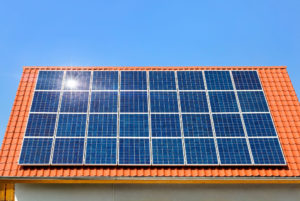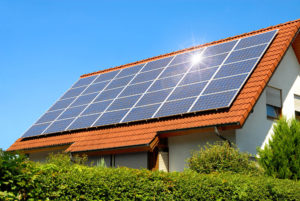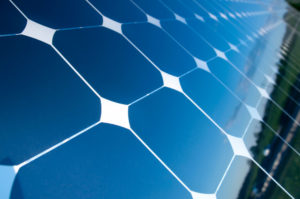Solar trackers are the ultimate solution to make the most of daylight. Solar energy and electricity production heavily depend on solar panels’ sunlight. Additionally, the angle at which the sun rays fall on the panel affects electricity production too!
A solar system produces the most electricity when the sun’s rays fall perpendicularly on it. Fixed solar panels only get a small window during the day where the sun’s rays are perpendicular to the solar panel. However, with sun-tracking, this small window can be busted wide open.
Sun tracking is one way to adjust the angle of the panels concerning the sun’s position during the day. Solar tracking or axis tracking allows panels to face the sun by tilting their axis. It enhances electricity generation and is popular in commercial settings.
This revolutionary tech, however, does not come cheap. You need to know that panels with solar trackers cost significantly more than fixed solar panels. Please continue reading to learn more about their cost and the benefits of installing solar trackers in your panel setups.
Contents
- 1 Key Takeaways
- 2 What are Solar Trackers?
- 3 Types of Solar Trackers
- 4 How Much Does It Cost to Install Solar Trackers?
- 5 What are The Pros and Cons of Solar Trackers?
- 6 Is it Worth Investing in a Solar Tracking System?
- 7 Case Study: Implementing Solar Trackers for a Commercial Solar Installation
- 8 Expert Insights From Our Solar Panel Installers About Solar Tracker Costs
- 9 Discover the Power of Solar with Solar Panels Network
- 10 To Conclude With
Key Takeaways
- Solar trackers enhance electricity generation by adjusting solar panels to follow the sun’s movement, maximising sunlight absorption.
- There are three common types of solar trackers: manual, active, and passive, each with varying costs and maintenance requirements.
- The cost of installing solar trackers can range from £800 to £4,000, depending on the model and the number of panels. This makes them more suitable for limited space, or peak energy production is critical.
What are Solar Trackers?
Solar trackers are devices used to maximise the intake of the sun’s rays by solar panels. Solar panels must be at the perfect angle with the sun to absorb the most sunlight and convert it to usable energy. However, maintaining this angle is not easy for stationary solar panels.
Installing a tracking system in your solar panels enables them to move according to the sun’s movement. It allows them to maintain the angle of incidence at exactly 90 degrees between the panels and the sun’s rays. The angle between the two determines the total productivity of the solar panel system, and the energy production efficiency is maximum when the panel is oriented at a right angle to the sun.
They have excellent large-scale commercial installations. They significantly increase the amount of electricity generated by solar panel systems. You can find these solar panels in industrial/commercial settings like solar trees instead of residential ones.

Types of Solar Trackers
There are many different types of solar tracking systems. The difference between these systems is the way they move and the direction of their orientation. Each panel type has a different cost and comes with varying maintenance costs.
Here are the three types of solar tracking systems commonly found in solar panel installations.
Manual Solar Trackers
Manual trackers are rather primitive as they must be physically adjusted per the sun’s position. That means someone has to keep an eye on the sun’s position and then manually adjust the angle of the solar panels so they are perpendicular to the sun’s rays.
Active Solar Trackers
An active solar tracker is one of the most convenient solar tracking systems you can install. The solar trackers use hydraulic movement or cylinders to change the angle of the solar panels. Their cost is a little higher than a manual solar panel and depends on the quantity required for installation.
Passive Solar Trackers
Passive solar trackers use liquids with low boiling points to tilt their axis. During the day, This liquid evaporates and creates an imbalance in the central axis of the solar panel. The imbalance further enables the solar panels to tilt their axis and position their surface in line with the sun’s rays.
The types of solar panels mentioned above are categorised based on their mechanism and inner workings. However, solar tracking systems can further be divided into two more categories. These categories were created based on the axis tracking system and the direction they will tilt.
Here are the two types of solar tracking systems based on the tilt of their axis.

Single-Axis Solar Tracker
A single-axis solar tracker system can tilt the solar panels from east to west during the day. It will allow them to follow the sun throughout the day and help increase productivity by 25% to 30%. They are known as single-axis solar trackers because they can only move along one axis, i.e. from east to west.
Dual-Axis Solar Tracker
Large-scale commercial setups use Dual-axis solar tracker systems because these trackers allow panels to move along two axes. That means the solar panels can move from north to south and east to west, and the sun moves across the sky. This dual-axis solar panel tracking system helps increase energy production throughout the year irrespective of the earth’s position to the sun due to the north and south axis.
How Much Does It Cost to Install Solar Trackers?
Solar trackers can be installed in solar panel systems and incorporated into projects based on requirements. Solar tracking systems can be installed in solar panels, but this installation will significantly increase your investment.
If you wish to add solar trackers to a solar panel system setup, it will cost extra for their installation. Depending on the model you pick and the number of installed solar panels, a tracking system will cost you anywhere between £800 to £4000. A single-axis tracker generally costs about 35% of the total cost of your solar panels.
A solar tracking system also has maintenance, installation, and tracker costs that you need to consider. If you do not have much room in your budget after installing a solar panel system, you might want to reconsider solar tracking system installation.
If you choose to install a dual-axis solar panel tracking system, then the cost of installation will be higher.
Manual solar tracking systems are certainly more cost-effective than active solar trackers. However, installing trackers automatically tilt their position throughout the day makes more sense. This way, you can use solar energy without worrying about changing the panel’s position throughout the day.
Here are the estimated costs of a typical solar PV system ranging from a one kilowatt-peak (kWp) to a 4kWp system on a single-axis tracker.
| System Size | Cost of tracker |
|---|---|
| 1kWp | £850 |
| 2kWp | £1,701 |
| 3kWp | £2,552 |
| 4kWp | £3,403 |
What are The Pros and Cons of Solar Trackers?
There are many benefits of getting solar trackers for your panels. However, while there are definite pros, the setup has a few cons. Here’s everything you need to know about the benefits of solar trackers.
Pros
- A solar tracker enables you to generate more energy than a stationary or fixed array because it moves with the sun.
- A wide range of solar trackers is available, so you can find the right fit and make the most of the solar radiation you receive.
- A solar tracking system helps with electricity generation during peak hours.
- You will not have to take energy supply from the grid as you will produce more energy for longer periods during the day.
- Dual-axis trackers help produce more energy throughout the year with the help of their north and south axes.
- Axis trackers increase energy production by 30%, even in regions with scanty sunlight.
Cons
- They are not very cost-effective. Installing solar trackers can be double the price of a fixed array solar panel setup.
- A solar tracker system has high maintenance costs as it has moving parts and requires regular maintenance checks and repairs.
- A solar tracker system requires additional wiring installation and much more space than an array of ground-mounted panels.
Is it Worth Investing in a Solar Tracking System?
While solar trackers and a solar tracking system seem lucrative for large solar panel setups, chances are you are likely to save more on the cost if you opt out of this option. That is because the cost of solar panels has decreased over the last few years, and getting more panels is cheaper than installing a solar tracking system in the ones you already have.
Solar panels will give you a better return on your investments in a shorter term when compared to a tracking system. For instance, a 3.5kWp solar panel setup (around £6,500) on a single-axis tracker would cost you around £2,980.
If you get a single-axis tracking system, it will cost you between £800 to £4,000.
Tracking systems are an excellent option for a solar panel system that is short on space and needs to maximise sun-tracking due to its fixed solar position.

Case Study: Implementing Solar Trackers for a Commercial Solar Installation
Background
Solar Panels Network recently undertook a project for a large commercial facility looking to optimise its energy production from a solar PV system. The client had limited roof space but a high energy demand, making it essential to maximise the efficiency of the installed solar panels. After assessing the site and the client’s energy needs, we recommended the installation of a solar tracking system to enhance energy capture throughout the day.
Project Overview
The primary goal was to install a solar PV system with trackers that could follow the sun’s path, thus increasing the panels’ exposure to sunlight and, consequently, energy production. The client was keen on using renewable energy to lower operational costs and reduce their carbon footprint.
Implementation
- Site Assessment: Conducted a thorough analysis of the roof’s structural capacity and potential shading issues.
- System Design: Designed a solar PV system incorporating single-axis trackers to optimise the angle of the panels throughout the day.
- Installation: Deployed a team of engineers to install the solar panels and trackers. The installation included additional wiring and structural support to accommodate the tracking system.
- Calibration and Testing: Calibrated the tracking system to ensure accurate alignment with the sun’s trajectory and conducted comprehensive testing to verify the system’s performance.
Results
- Increased Energy Production: The tracking system increased energy output by approximately 30%, significantly enhancing the facility’s energy independence.
- Cost Savings: Despite the higher initial investment, the client saw substantial savings on energy bills, reducing their reliance on the grid.
- Sustainability Impact: The project resulted in a marked reduction in the facility’s carbon footprint, aligning with the client’s sustainability goals.
Summary
The implementation of solar trackers in this commercial project proved to be a highly effective strategy for maximising energy production. By utilising single-axis trackers, we increased the solar panels’ efficiency, allowing the client to generate more electricity within a limited space. The initial costs were offset by long-term savings and environmental benefits, making it a sound investment. At Solar Panels Network, we specialise in providing tailored solutions that meet the unique needs of our clients, ensuring they achieve both financial and environmental benefits from their solar installations.
Expert Insights From Our Solar Panel Installers About Solar Tracker Costs
Solar trackers are a game-changer for energy efficiency. By optimising the angle of the panels throughout the day, we can significantly increase energy output, making it a worthwhile investment despite the higher initial costs.
Senior Solar Technician
Investing in solar trackers can be particularly beneficial for commercial installations where space is limited, and maximising energy production is crucial. It’s all about getting the most out of every square metre.
Commercial Solar Project Manager
While the upfront costs of solar trackers are higher, the long-term benefits in terms of energy savings and reduced grid dependency make them an excellent choice for those looking to maximise their solar investment.
Renewable Energy Consultant
Discover the Power of Solar with Solar Panels Network
Are you navigating the world of solar installations? Look no further than Solar Panels Network, the UK’s trusted partner in harnessing the sun’s potential. Our dedication goes beyond just installations; we’re on a mission to transform how homeowners and businesses across the UK perceive and utilise energy. By choosing us, you’re reducing your carbon footprint and making a smart financial move that promises savings for years ahead. Contact us today and embark on your solar journey.
To Conclude With
Tracking systems are an excellent way to maximise the solar energy converted into electricity. Dual- and single-axis solar tracking systems can generate more electricity than fixed solar systems. However, the only downside of this setup is the cost, so if you have no trouble doubling your budget for a panel setup, this is an excellent option.
About the Author
Solar Panels Network stands at the forefront of solar energy solutions, driven by a team of seasoned solar engineers and energy consultants. With over decades of experience in delivering high-quality solar installations and maintenance, we are committed to promoting sustainable energy through customer-centric, tailored solutions. Our articles reflect this commitment, crafted collaboratively by experts to provide accurate, up-to-date insights into solar technology, ensuring our readers are well-informed and empowered in their solar energy decisions.
